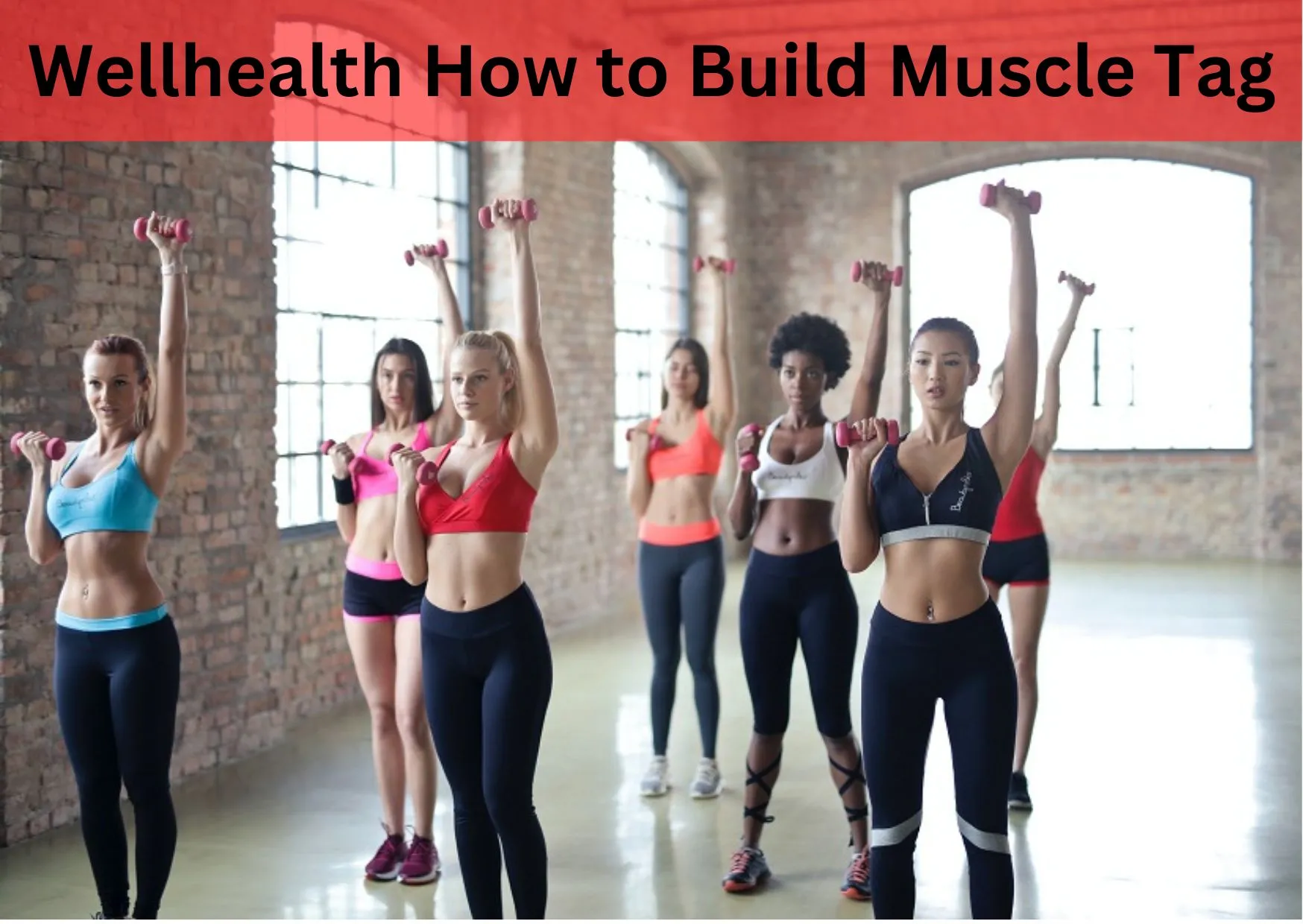
Wellhealth How to Build Muscle Tag Faster: Muscle Mastery Guide
Table of Contents
Introduction:
In the pursuit of a stronger, healthier body, understanding the principles of muscle building is paramount. Achieving muscle mastery is not just about lifting weights; it’s a holistic journey that encompasses various aspects of well-being. In this comprehensive guide, we’ll explore how to accelerate your muscle-building journey through the lens of well-health principles.
Section 1: Foundations of How to Build Muscle Tag
Building a foundation for building muscle tag faster requires a thoughtful integration of nutrition, workout planning, and a keen understanding of how these elements interact. Let’s delve into the key components that form the bedrock of accelerated and sustainable muscle building.
1.1 Balanced Nutrition for Optimal Muscle Growth:
Nutrient-Rich Diet:
Fueling your body for muscle growth begins with a nutrient-rich diet. Proteins, the building blocks of muscle, are crucial. Include lean meats, dairy, legumes, and plant-based protein sources to ensure an adequate supply of essential amino acids.
Healthy Fats and Carbohydrates:
Incorporate healthy fats and complex carbohydrates to provide sustained energy for your workouts. Avocados, nuts, whole grains, and fruits are excellent choices. Striking a balance between macronutrients is essential for overall well-health and optimal muscle function.
Micronutrient Considerations:
Vitamins and minerals play a vital role in supporting various physiological processes, including muscle contraction and recovery. Ensure your diet includes a diverse range of fruits, vegetables, and whole foods to meet your micronutrient requirements.
1.2 Strategic Workout Planning:
Progressive Overload:
Wellhealth how to build muscle tag requires a systematic approach to training. Progressive overload, the gradual increase of stress on the body during exercise, is fundamental. This can be achieved by increasing weights, reps, or intensity over time. Understand the importance of progression in your workout routines.
Variety in Training Modalities:
Muscle adaptation thrives on diversity. Incorporate a variety of exercises that target different muscle groups. This not only prevents monotony but also ensures comprehensive muscle development. Explore resistance training, cardiovascular exercises, and flexibility workouts for a well-rounded approach.
Strategic Rest Intervals:
Optimizing rest intervals between sets is a critical aspect of workout efficiency. Tailor rest periods to your fitness goals—shorter rests for hypertrophy and longer rests for strength building. Strategic planning ensures that your workouts are both challenging and sustainable.
In this foundational section for muscle tag, the emphasis is on creating an environment within your body that is conducive to muscle growth. By addressing the nutritional aspects and structuring your workouts strategically, you lay the groundwork for a successful and sustainable muscle-building journey. These principles not only contribute to physical development but also promote overall well-being, aligning your fitness goals with a holistic approach to health.
Section 2: Mindful Muscle Building Techniques
Achieving muscle mastery involves more than the physical aspect of lifting weights. The mind plays a crucial role in the journey towards accelerated muscle building. In this section, we explore the profound connection between mental well-being and physical performance, emphasizing the importance of mindfulness techniques.
2.1 Mind-Body Connection:
Conscious Muscle Engagement:
Mindful muscle building begins with cultivating a strong mind-body connection. Instead of going through the motions, focus on consciously engaging the muscles you are targeting during each exercise. This heightened awareness enhances the effectiveness of your workouts, ensuring that you’re maximizing each repetition.
Visualization Techniques:
Incorporate visualization into your training routine. Before lifting, visualize the muscle groups at work. This mental rehearsal enhances neural pathways, making your movements more precise and efficient. Visualization also serves as motivation, helping you picture the results you aspire to achieve.
Mindfulness Meditation:
Integrate mindfulness meditation into your overall routine. Dedicate a few minutes each day to mindfulness practices, such as focused breathing or guided meditation. These techniques not only reduce stress but also foster a calm and focused mindset, which is invaluable for optimal muscle building.
2.2 Quality Sleep for Quicker Gains:
The Role of Sleep in Recovery:
Quality sleep is a cornerstone of mindful muscle building. During deep sleep, the body undergoes repair and regeneration, crucial for muscle recovery and growth. Aim for 7-9 hours of uninterrupted sleep each night to optimize the benefits of your training efforts.
Establishing a Bedtime Routine:
Create a calming bedtime routine to signal to your body that it’s time to wind down. This could include activities such as reading, gentle stretching, or practicing relaxation techniques. Consistency in your sleep schedule reinforces your body’s natural circadian rhythms.
Addressing Sleep Disruptors:
Identify and address factors that may disrupt your sleep, such as excessive screen time before bed or consuming stimulants late in the day. Creating a sleep-conducive environment and addressing lifestyle factors contribute significantly to the quality of your sleep.
In this section, we recognize that the mind is a powerful ally in the pursuit of accelerated muscle building. By fostering a strong mind-body connection and prioritizing quality sleep, you not only enhance the effectiveness of your workouts but also promote overall well-being. The incorporation of mindfulness techniques aligns your mental and physical efforts, creating a harmonious approach to muscle mastery.
Also Read: WellHealthOrganic Ayurvedic Health Tips for a Balanced Life
Section 3: Well-Health Recovery Strategies
Building muscle is not just about the intensity of your workouts; it’s equally about the quality of your recovery. In this section, we explore recovery strategies that go beyond the gym, focusing on the importance of nutrient timing, rest, and active recovery.
3.1 Nutrient Timing for Recovery:
Post-Workout Nutrition Essentials:
The period immediately after your workout is a critical window for replenishing energy stores and initiating the muscle repair process. Prioritize a post-workout meal or snack that combines protein and carbohydrates. This could include a protein shake with a source of fast-digesting carbohydrates or a balanced meal with lean protein and whole grains.
Hydration for Recovery:
Hydration is often overlooked but is a key component of effective recovery. Water supports nutrient transport, temperature regulation, and overall cellular function. Ensure adequate hydration before, during, and after your workouts to optimize recovery processes.
Supplements for Support:
Consider incorporating well-chosen supplements to aid recovery. Branched-chain amino acids (BCAAs) and creatine, for example, have been shown to support muscle recovery and growth. Consult with a healthcare professional or a nutritionist to determine the right supplements for your specific needs.
3.2 Incorporating Rest and Active Recovery:
The Role of Rest Days:
Rest days are not a sign of weakness but a crucial element of a well-structured fitness routine. Muscles need time to repair and grow stronger. Plan regular rest days into your training schedule, and listen to your body. Overtraining can lead to burnout and hinder long-term progress.
Active Recovery Techniques:
Active recovery involves engaging in low-intensity activities to promote blood flow and reduce muscle stiffness. This could include activities like walking, yoga, or light swimming. Active recovery helps prevent muscle imbalances and contributes to overall flexibility and joint health.
Massage and Stretching:
Incorporate massage and stretching into your recovery routine. These practices enhance flexibility, reduce muscle tension, and promote circulation. Foam rolling, in particular, can be an effective self-massage technique to alleviate tightness in specific muscle groups.
By prioritizing recovery through strategic nutrient timing, hydration, and a balanced approach to rest, you set the stage for consistent and sustainable muscle development. Recognizing the importance of recovery as an integral part of your fitness journey is key to unlocking long-term success and maintaining overall well-health.
Section 4: Well-Being Beyond the Gym
Building muscle and achieving well-health go hand in hand with practices that extend beyond the confines of the gym. In this section, we explore the interconnectedness of well-being, stress management, hormonal balance, hydration, and their profound impact on the muscle-building journey.
4.1 Stress Management and Hormonal Balance:
Understanding the Stress-Muscle Connection:
Chronic stress can have detrimental effects on your body’s ability to build and maintain muscle. Stress triggers the release of cortisol, a hormone that, in excess, can lead to muscle breakdown and hinder growth. Explore stress management techniques such as meditation, deep breathing exercises, and activities that promote relaxation.
The Role of Hormones in Muscle Building:
Hormonal balance is crucial for optimal muscle development. In addition to cortisol, hormones like testosterone and growth hormone play key roles. Adequate sleep, a balanced diet, and stress reduction contribute to a hormonal environment conducive to muscle growth.
4.2 Hydration and Muscle Performance:
The Significance of Hydration:
Hydration is often underestimated in its impact on muscle performance. Water is essential for nutrient transport, temperature regulation, and overall cellular function. Dehydration can lead to fatigue, cramping, and decreased exercise performance. Aim to maintain optimal hydration levels throughout the day, especially before, during, and after workouts.
Balancing Electrolytes:
Electrolytes, such as sodium, potassium, and magnesium, play a crucial role in muscle function. Replenishing electrolytes lost through sweat is essential, especially during intense workouts. Consider sports drinks or natural sources like coconut water to maintain electrolyte balance.
4.3 Holistic Approaches to Well-Being:
Incorporating Holistic Practices:
Well-being extends beyond physical health; it encompasses mental and emotional aspects as well. Explore holistic practices such as yoga, mindfulness meditation, and nature walks. These activities not only contribute to stress reduction but also foster a sense of overall well-being.
Community and Social Connections:
Building a strong support system and engaging in positive social connections contribute to your overall well-being. Share your fitness journey with others, join group classes, or find a workout buddy. The sense of community can provide motivation and emotional support.
In this final section, we recognize that the pursuit of muscle mastery is inseparable from well-being in its holistic sense. By managing stress, balancing hormones, prioritizing hydration, and embracing holistic well-being practices, you not only enhance your muscle-building efforts but also promote a sustainable and fulfilling lifestyle. The journey goes beyond physical aesthetics; it becomes a transformative experience that aligns with your broader goals of health, happiness, and vitality.
Conclusion:
Wellhealth how to build muscle tag is a multifaceted endeavor that extends beyond the weights you lift. By integrating well-health principles into your muscle-building journey, you can expedite the process and attain a level of strength and vitality that goes beyond physical appearance. Embrace the holistic approach outlined in this guide, and unlock the full potential of your body’s muscle-building capabilities.


